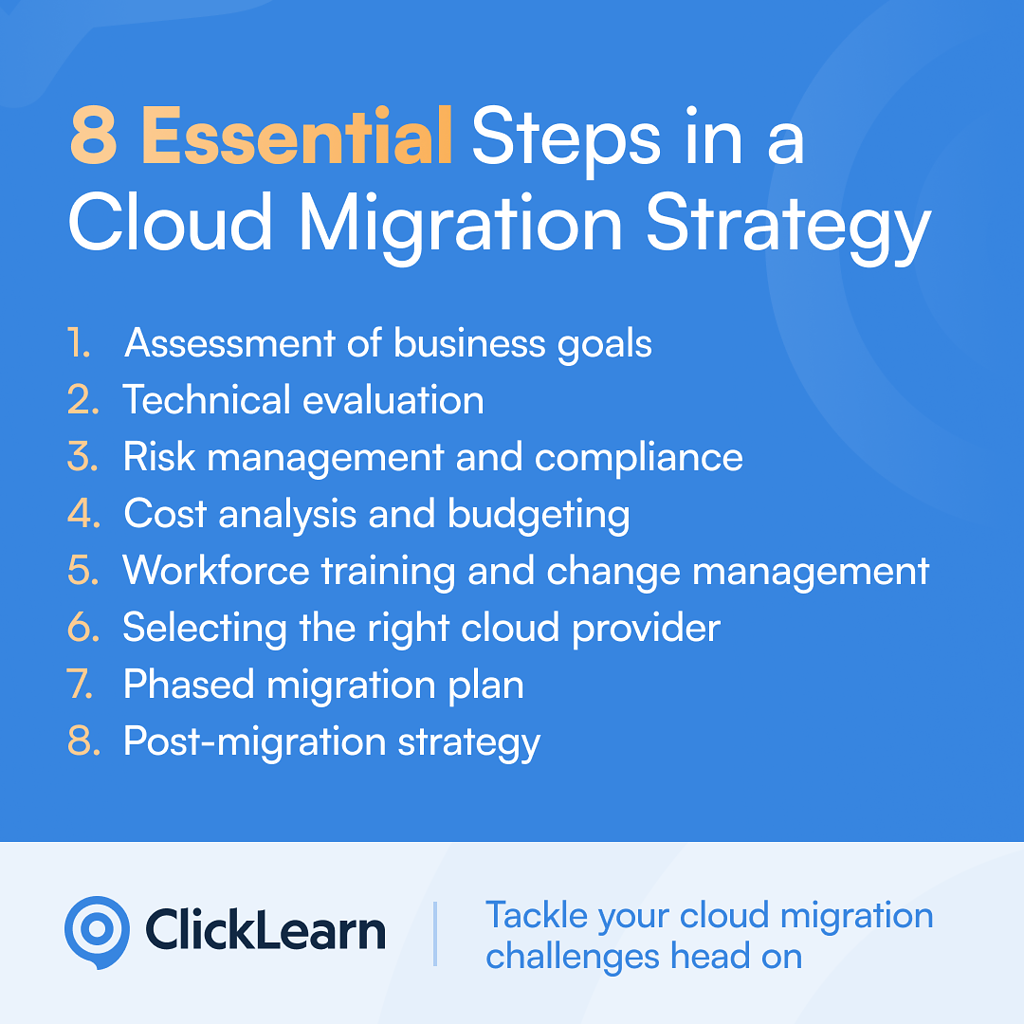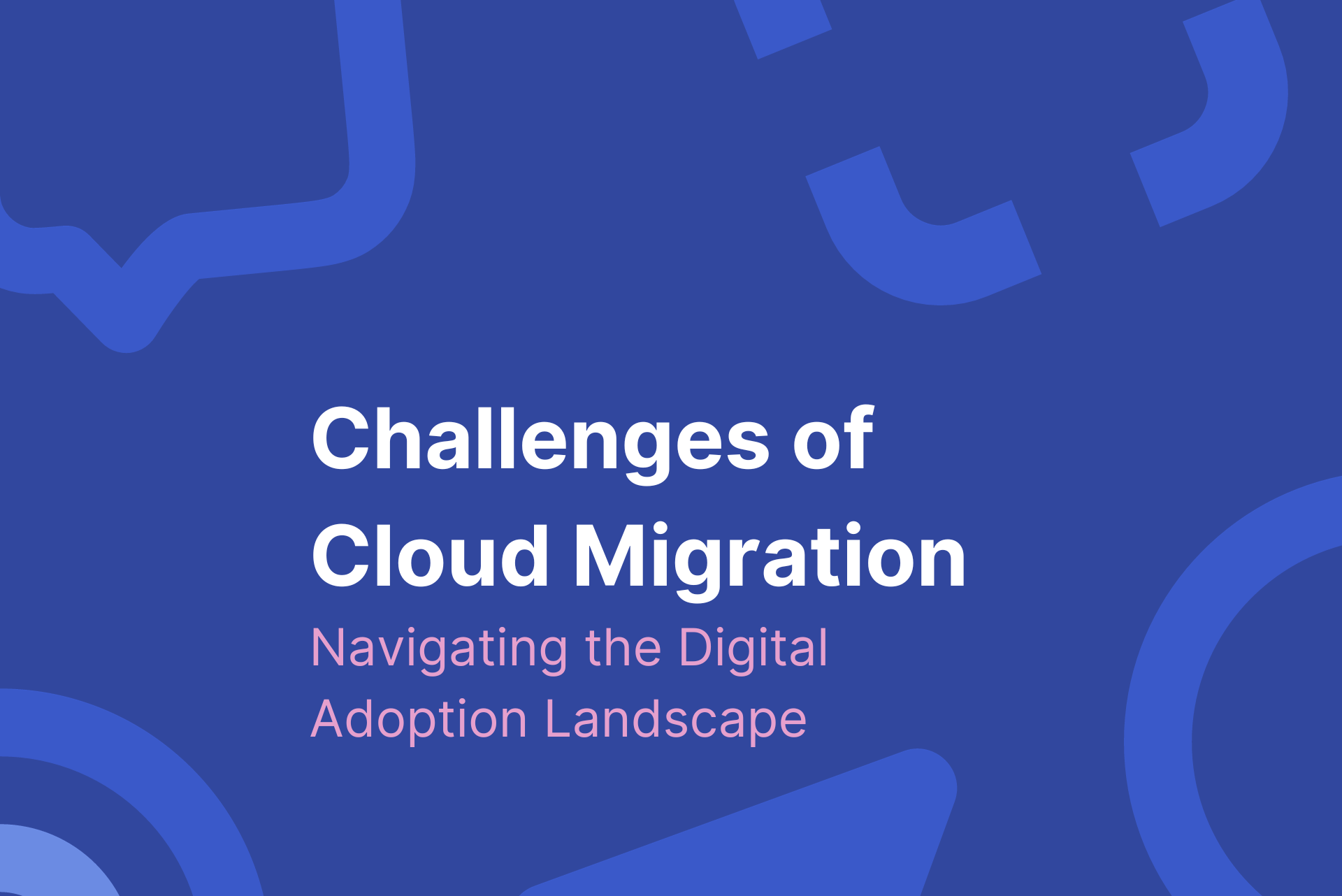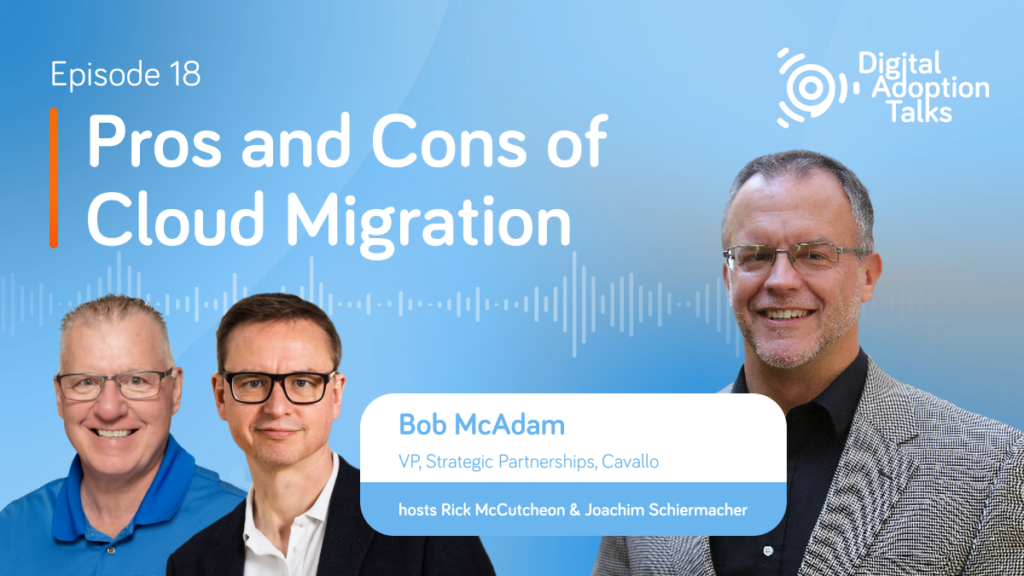What is cloud migration?
Cloud migration refers to the process of moving digital assets – such as data, applications, IT processes, and services – from an on-premises data center to the cloud. This transition can involve moving to a public cloud, a private cloud, or a hybrid of both. The key objectives of cloud migration include improving scalability, operational efficiency, and cost-effectiveness of IT services, as well as fostering innovation and agility within the organization.
Cloud migration strategies can vary, ranging from the 'lift-and-shift' approach, where existing applications are moved to the cloud with minimal changes, to more complex re-architecting or re-platforming, which may involve significant modifications to optimize for cloud environments.
The strategic imperative of cloud migration
Cloud migration is often viewed as a strategic imperative for modern businesses, yet its value and applicability vary widely. Bob McAdam, Vice President of Strategic Partnerships at Cavallo and a veteran in the Microsoft Dynamics space, has witnessed this technological shift first-hand. His journey, which began in the late ’90s during the shift from DOS to Windows systems, offers a unique perspective on the evolution of cloud technologies. As he notes, “there’s never a dull moment in the Microsoft Dynamics Channel.”
It’s important to note that cloud migration is not a one-size-fits-all solution. While enterprise software vendors are all-in on digital adoption and keen to move customers to cloud solutions, this transition may not hold intrinsic value for every business. In the Digital Adoption Talks episode, McAdam and McCutcheon delve into this complexity, questioning the blanket approach often taken in the industry.
While enterprise software vendors are keen on digital adoption, moving to cloud solutions may not be universally beneficial to all. McAdam discusses this complexity, questioning the general approach in the industry: “I can’t find one [vendor] who has said I’m all about being on-premises and we’re going to hold the line on digital adoption.”
8 common challenges of cloud migration
Navigating the path of cloud migration involves confronting various challenges that can impact an organization’s transition and operational efficiency. The most common cloud migration challenges include:
- Financial considerations: The cost implications of cloud migration can be substantial, encompassing expenses related to technology upgrades, personnel training, and system integration. McAdam, reflecting on the financial aspect, highlights the need for meticulous budgeting and resource allocation, especially for smaller organizations where financial constraints are more pronounced.
- Technical compatibility and integration: Ensuring compatibility between legacy systems and new cloud infrastructure is a significant challenge. This often necessitates substantial modifications to existing systems or even complete overhauls to align with cloud architectures.
- Data security and compliance: As businesses migrate to the cloud, they must navigate the complexities of securing data and adhering to regulatory compliance standards. This requires a strategic approach to data governance and security protocols, tailored to the cloud environment.
- Skill gaps and workforce readiness: The transition to cloud-based systems requires specialized skills and knowledge. Bridging the skill gap within existing IT teams and ensuring they are equipped to manage and operate cloud technologies is essential for a successful migration.
- Operational disruption and downtime: Minimizing operational disruptions during the migration process is a critical challenge. Businesses must strategize to ensure continuity of services and mitigate the impact on day-to-day operations.
- Adoption resistance and change management: Resistance to change within an organization can impede the adoption of new technologies. Effective change management strategies are crucial to foster acceptance and smooth transition among the workforce.
- Vendor lock-in and flexibility: Choosing a cloud provider often involves navigating potential vendor lock-in scenarios. Organizations must carefully evaluate their options to ensure flexibility and avoid being constrained by a single vendor’s ecosystem.
- Long-term strategic alignment: Ensuring that cloud migration aligns with the organization’s long-term strategic goals is paramount. This involves assessing how cloud services will support future growth and adaptability.
Financial costs, for instance, encompass everything from rewriting application architecture to investing in training. McAdam highlights the need for careful consideration and planning, especially for smaller businesses facing an “uphill battle” in the cloud migration journey.
Similarly, adoption resistance is a significant barrier, often stemming from the human tendency to resist change. McAdam’s insights into the Dynamics ecosystem shed light on this, pointing out the disruptions caused by new systems and processes in organizations accustomed to a certain way of operation.
Addressing skill gaps and compatibility issues
One of the primary hurdles in cloud migration is the skill gap in handling new cloud technologies and the compatibility of legacy systems with modern cloud environments. As McAdam points out, “We’re all trying to compete for the best solution possible,” highlighting the industry’s rush towards cloud solutions without necessarily considering the compatibility with existing systems or the readiness of the IT workforce.
Organizations are commonly advised to cultivate cloud skills internally, a strategy that McAdam’s experience supports. His journey through various roles in the Dynamics ecosystem underscores the importance of understanding legacy systems and the need for continuous learning to adapt to rapidly evolving cloud technologies.
To effectively address skill gaps and compatibility issues in cloud migration, businesses should first conduct a skills audit to identify areas where upskilling is needed. Prioritizing training in cloud technologies is important, with a focus on areas most relevant to your organization’s needs. Consider partnerships with cloud service providers for specialized training programs.
For compatibility, it’s recommended to perform a thorough analysis of existing systems against the requirements of your chosen cloud infrastructure. Develop a roadmap for upgrading or replacing incompatible systems and software and regularly review and update these plans to align with technological advancements and evolving business needs.
Financial considerations and cost management
Financial planning is another cornerstone of cloud migration. Cloud platforms might appear cheaper than on-premises options at first glance, but hidden fees such as data transfer costs and additional support and training can quickly add up.
This perspective aligns with McAdam’s views on financial considerations for cloud migration, especially for smaller businesses that might find the transition financially daunting. Developing a comprehensive financial plan for cloud migration involves several steps.
Begin by itemizing all potential costs, including initial migration expenses, ongoing cloud service fees, and any ancillary costs like additional bandwidth or storage needs. Compare these against the cost savings cloud migration might offer, such as reduced on-premises infrastructure maintenance. Utilize cost estimation tools provided by cloud service providers to get a realistic view of expenses. Once you have a clear overview of the financials, establish a budget that accounts for both immediate migration costs and long-term operational expenses. Regularly review and adjust the budget based on actual cloud usage and evolving business requirements.
Security concerns in cloud migration
Migrating to the cloud introduces a new set of security challenges and considerations. The shift necessitates a re-evaluation of existing security protocols and, commonly, the adoption of new practices tailored to the cloud environment. During the Digital Adoption Talks episode, McAdam and McCutcheon discuss the importance of being acutely aware of these changes and adapting security strategies to protect data and ensure compliance in the cloud.
In the cloud, data is not stored in a single physical location but is distributed across multiple servers, potentially across global locations. This distribution poses unique security risks such as data breaches, unauthorized access, and data loss.
To mitigate these risks, organizations must implement robust security measures, including advanced encryption methods for data at rest and in transit, and multi-factor authentication to control access. Regular security audits and vulnerability assessments should become a part of the routine to identify and address any potential security gaps.
Prioritizing and planning for effective migration
A well-structured cloud migration plan is vital for minimizing disruption and achieving a successful transition.
Bob McAdam’s analogy of moving from DOS to Windows is particularly relevant here, illustrating the need for careful planning and a strategic approach in cloud migration. He suggests, “Sometimes you just got to stop and take a breath and examine your business,” advocating for a thoughtful and phased approach to migration that aligns with business objectives and stakeholder needs.
A well-structured cloud migration plan requires a detailed and systematic approach. Organizations should start by prioritizing which applications and data should move to the cloud, considering factors like business importance, data sensitivity, and application complexity. It’s also important to develop a migration roadmap that outlines each phase of the migration, including timelines, milestones, and specific tasks.
Consider employing project management tools to monitor progress and address issues promptly. Ensure each phase of migration includes testing and validation to confirm successful integration and performance in the cloud environment. After each phase, gather feedback and learnings to refine the approach for subsequent phases.
The role of reseller partners and Dynamics partners
A critical aspect of cloud migration, especially in the Dynamics ecosystem, is the role played by reseller partners. McAdam discusses the challenges Dynamics partners face, from meeting publisher goals to navigating the complexities of partner ecosystems.
This conversation highlights the pressure these partners often experience, which can sometimes overshadow the actual requirements and readiness of their clients for cloud migration. The balance between vendor pressures and stakeholder needs becomes a pivotal point in ensuring successful digital adoption.
McAdam points out the pressure they experience discussing the role of reseller partners: “I’m all about digital adoption and moving to the cloud, but I want it to be the right decision for the stakeholder.”
Educating and supporting end users
Supporting and educating end users is a crucial aspect of the cloud migration process and successful organizational digital transformation.
McAdam emphasizes the need for ongoing education and adaptation: “It’s the same thing all over again. They know it’s a trend in technology that [the end users] need to be [onboard], but there’s a lot to absorb [when it comes to documentation and education].”

Successful cloud migration consists of effectively managing security risks, controlling costs, addressing skill gaps, ensuring technical compatibility, and strategically aligning the migration with your organization’s long-term goals.
Educating and supporting end users in a cloud migration initiative involves a strategic approach to training and communication. Develop a comprehensive training program tailored to different user roles and their specific interactions with the new cloud systems. Utilize a mix of training methods, including workshops, eLearning modules, and hands-on sessions, to accommodate diverse learning preferences.
It’s recommended to communicate regularly with end users about the benefits of cloud migration, addressing any concerns or resistance they may have. Consider establishing a support system, including a help desk and user communities, to assist users during and after the transition. Regularly gather user feedback to continuously improve training and support mechanisms.
Using a digital adoption platform like ClickLearn ensures that end users can practice the new software interface in a guided environment and access different formats of documentation and training materials, ensuring that onboarding and continuous learning is as easy as possible.
8-step guide for creating a cloud migration strategy
A successful cloud migration strategy is fundamental for businesses transitioning to cloud computing. This strategy must be comprehensive, incorporating several key aspects, including the following:
1. Assessment of business goals for cloud adoption
The initial step in a detailed cloud migration strategy involves aligning the cloud migration with the organization’s broader objectives.
Determining which cloud services and cloud infrastructure models best align with business goals, such as enhancing operational efficiency or expanding capacity, is crucial. This phase also includes evaluating how cloud adoption fits into the company’s cloud adoption framework and understanding the implications of choosing between public cloud, private cloud, or hybrid cloud solutions.
It’s essential to assess how cloud technology can drive business growth and support the development of new services or products.
2. Technical evaluation in the cloud migration process
A thorough assessment of the current IT infrastructure is crucial to understand the scope of the cloud migration. Identifying which applications and data are suitable for data migration to the cloud environment and which may require re-architecting to fit into the new cloud architecture is vital.
This evaluation should consider the compatibility of existing database systems with cloud platforms and the potential need for significant new systems or cloud-driven development processes. Understanding the architectural changes, such as moving to a virtual private cloud or adopting new cloud service models, forms the core of this phase.

When creating a cloud migration strategy, a comprehensive approach will typically take these 8 essential steps into consideration.
3. Risk management and compliance in cloud migrations
Managing risks, particularly cloud migration security challenges, is a critical part of the migration strategy. Addressing security risks, ensuring data security and compliance, especially for sensitive data, and developing robust security measures for data governance in the cloud platform is key.
Establishing appropriate security controls to protect against data breaches and ensuring business continuity during security incidents is vital. Additionally, navigating compliance risks and adhering to regulatory standards is crucial for businesses in sectors like healthcare and finance.
4. Cost analysis and budgeting for cloud migration costs
Evaluating the total cost of ownership is essential in the cloud migration process. This includes not only the direct costs of migrating to the cloud but also ongoing expenses associated with operating in a cloud environment.
Creating a budget that accounts for both the immediate and long-term financial impacts is crucial for maximizing cloud migration benefits. This process should consider potential savings from reduced hardware expenses, the cost efficiencies of scalable cloud resources, and the budgetary implications of different cloud service providers.
Understanding the pricing models of various cloud solutions, such as pay-as-you-go or subscription-based models, is also crucial in this phase.
5. Workforce training and change management in cloud adoption
Preparing the team for cloud adoption is vital. This involves providing training on cloud technology and implementing change management strategies to address cloud migration resistance and ensure smooth adoption of the new systems.
It’s crucial to foster a culture that embraces digital transformation and views migration as an opportunity for growth and innovation. Addressing the cloud environment adoption resistance requires clear communication about the benefits and the impact of the new technology on day-to-day operations.
6. Selecting the right cloud provider
Choosing an appropriate cloud service provider is a key decision in the cloud migration strategy. Factors such as the cloud provider’s performance, reliability, security, and support should be considered to ensure they align with the organization’s technical and operational needs.
Evaluating the cloud service offerings, understanding the service level agreements, and considering the long-term viability of the cloud vendor is critical. Additionally, assessing the ease of integration with existing systems and the provider’s ability to support future technology needs is essential.
7. Phased migration plan for cloud migrations
A phased approach to the migration process is advisable for managing complexity and minimizing risks. This involves prioritizing workloads based on complexity and business importance and implementing a migration project plan that ensures seamless cloud deployments.
This plan should include a detailed timeline, clearly defined milestones, and mechanisms for tracking progress and measuring success. Testing each phase thoroughly before full deployment is crucial to ensure that each step of the migration aligns with the overall cloud strategy and business objectives.
8. Post-migration strategy for cloud computing
After migrating to the cloud, ongoing management and optimization of cloud resources are essential. This includes continuous monitoring of cloud platforms and adjusting the strategy to align with evolving business needs and advancements in cloud technology.
Regularly assessing cloud resource utilization, optimizing for cost and performance, and staying updated with new cloud service offerings are part of effective post-migration management. It’s also important to have a plan for regularly updating security protocols and ensuring compliance with emerging regulations.
Tackle cloud migration challenges and succeed in digital adoption
The journey through cloud migration, as discussed by industry experts like Bob McAdam and Rick McCutcheon on Digital Adoption Talks, is complex and requires a nuanced understanding of various challenges. By comprehensively addressing these challenges and implementing a well-rounded migration strategy, businesses can successfully navigate the intricacies of cloud migration, leveraging its benefits to drive growth and innovation in the digital age.
With digital adoption solutions like ClickLearn, you can ensure that your end users have the best possible learning experience during cloud migration.

